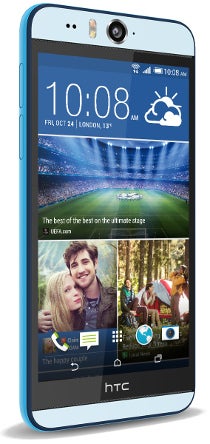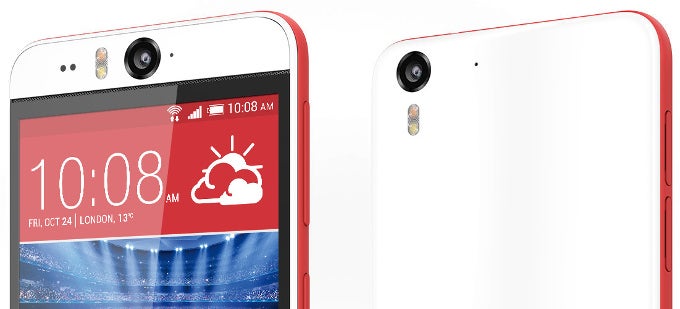HTC unveils the Desire EYE, a selfie-centric high-end smartphone with a 13MP camera at its front

HTC's most recent flagships, the HTC One and the HTC One (M8), have been getting quite a lot of flak due to their underperforming Ultrapixel rear cameras, but the company has been rarely criticized for failing to endow its high-end phones with good front-facing snappers. It looks that the company is trying to push the limits in this segment even more, as its latest device can easily snatch the crown and become the ultimate selfie phone from a well-known manufacturer.
Design

Oh, and HTC has finally jumped on the trendy-of-late water-resistant bandwagon, as the HTC Desire EYE is IPX7-certified, meaning that it can survive in up to 1 meter of water for as long as 30 minutes.
Hardware specs and features
The present 2,400mAh Li-Po battery will allegedly keep the lights on for as long as 538 hours in standby mode. Moving on to the connectivity department, we are happy to see that the HTC Desire EYE is LTE-enabled and supports AT&T's 2, 4, 5, 17, 29 bands, among others. Software-wise, HTC's latest comes with Android 4.4.2 KitKat out of the box, and rather unsurprisingly, HTC's homemade Sense 6 UI can be found on top of it.
Camera

Well, this is where the HTC Desire EYE truly shines, as the front-facing shooter of the device is a true zinger, at least on paper! We can find a duo of 13MP snappers both at the front and at the back, both endowed with dual LED flashes. The cameras are not strictly the same, though. The rear one has a wide-angle BSI (backside-illuminated) sensor with a 28mm lens and an f/2.0 aperture, whereas the selfie camera comes with a wider 22mm lens, but a smaller f/2.2 aperture. The front-facing camera also comes with auto-focus and will allow users to zoom in and out before taking the coveted self-portrait.
Both cameras of the HTC Desire EYE are HDR-capable and can record 1080p videos. The camera prowess of the device is also hinted by the dedicated two-step camera button on the side – a pretty rare sight these days. Unsurprisingly, HTC has also equipped the Desire EYE with a surplus of camera-oriented software features – we are dealing with HTC EYE™ Experience with Face Tracking, Screen Share, Split Capture, Face Fusion, Live Makeup, Auto Selfie, Voice Selfie, Photo Booth, and Crop Me In here, folks. Of course, a slightly redesigned HTC Zoe is also on board.
HTC elaborately explained what most of these do and it looks like that they are nothing short of welcome. EYE Experience's face tracking does not only keep your face in focus at all times, it can also track the faces of up to four people and keep them on focus and in the frame. Split Capture, on the other hand, uses the front camera to take a picture of you and the rear camera to record a brief video, afterwards combining them into one. Voice Selfie allows you to take a picture or record a video by saying one of the supported voice commands.
Follow us on Google News














Things that are NOT allowed:
To help keep our community safe and free from spam, we apply temporary limits to newly created accounts: